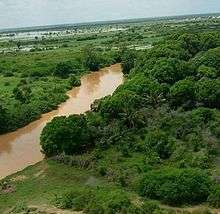Jowhar
- This article is about the Somali city. For the ancient Indian tradition of honorary self immolation, see Jauhar.
| Jowhar Giohar | |
|---|---|
| Town | |
 Jowhar Location in Somalia | |
| Coordinates: 2°47′N 45°30′E / 2.783°N 45.500°E | |
| Country |
|
| Region | Middle Shabelle |
| District | Jowhar |
| Elevation | 300 ft (100 m) |
| Population (2010) | |
| • Total | 62,000 |
| Time zone | East Africa Time (UTC+3) |

Jowhar (Somali: Jowhaar, Arabic: جوهر, Italian: Giohar, formerly Villaggio Duca degli Abruzzi) is the capital town of the Middle Shabelle region of Somalia. Along with Baidoa, it used to form the joint administrative capital of the Transitional Federal Government, which it captured from the Islamic Courts Union.
The town lies 90 km (50 mi) along a major road north of the national capital of Mogadishu.
History
Jowhar was founded by a senior member of the Italian Royal Family, H.R.H. Principe Luigi Amedeo, Duca degli Abruzzi in 1920, who first came to the African continent in 1905 and liked the place. The Duke raised funds to build dams, roads, a railway, schools, hospitals, a church and a mosque. He eventually married a Somali woman and died in his village.[1]
Villaggio Duca degli Abruzzi
As already stated, the Duca degli Abruzzi founded the eponymous Villaggio Duca degli Abruzzi in 1920 as an agricultural settlement in Italian Somalia experimenting with new cultivation techniques. In 1926, the colony comprised 16 villages, with some 3,000 Somali and 200 Italian inhabitants.

Situated in the Hawiye Somali clan strongholds between Galjecel, Afgaal and Shiidle, the area is of strategic importance. It is also of considerable economic value notably due to its banana, cotton and sugar plantations.
From 1911 in Jowhar (formerly Giohar), Italians like the Duca degli Abruzzi started to take the local farmers and resettle them in specific new villages in an attempt to improve the economy of Italian Somalia. The area around the Villaggio Duca degli Abruzzi was the most agriculturally developed of Somalia before World War II and had some food industries.[2]
In 1940, the Villaggio Duca degli Abruzzi (usually known in Italian simply as "Villabruzzi") already had a population of 12,000, of whom nearly 3,000 were Italian Somalis, and enjoyed a notable level of development as a small manufacturing area.
The Italians, who believed in the economic potential of the region, also built a railway system that linked Jowhar to Mogadishu for the next thirty years, and was used mainly to export bananas and coffee to Europe.
At independence, the vacuum created by the outgoing Italians was not filled by the new Somali élites in charge, as the latter deemed the cattle trade and urban assets more profitable.
After World War II

Jowhar changed name from the Italian Villaggio Duca degli Abruzzi to the actual name in 1960, when Somalia gained its independence.
With a "socialist" regime in 1969, such a fertile land was nationalized and was only available to cultivators through fifty years leases. The government fixed the prices of agricultural products and could purchase up to 80% of the harvests. Under Co-operative Act n°70 of 1973, petty farmers were expropriated again to leave place for the State orientated Fanoole Rice Farm, Mogambo Irrigation Project and Juba Sugar Complex.
Jowhar only became the regional capital in the mid-1980s when Mogadishu was taken out of Shabeellaha Dhexe to form its own region, Banaadir.
Administrative capital
As part of a 2004 agreement, Jowhar and the town of Baidoa were to form a joint administrative capital of the Transitional Federal Government, sited away from Mogadishu for security reasons. Continued fighting threatened to derail the peace process. However, in July 2005, President Abdullahi Yusuf Ahmed relocated to the town from his base in Bosaso, moving the process forward and joining Prime Minister Ali Mohammed Ghedi, who had already been resident in the town for a month. Part of the parliament became based in Jowhar, while some ministries were established in Mogadishu.[3] By February 2006, despite Ghedi's security concerns, the two leaders had left to Baidoa, where it was decided the parliament would convene.[4]
Recent history
On December 27, 2006, the internationally backed transitional government forces, united with Ethiopian troops, recaptured Jowhar from the Islamic Courts Union.[5]
On May 17, 2009, the Islamist al-Shabab militia took the town,[6] and imposed new rules, including a ban on handshaking between men and women.[7]
On December 9, 2012, Somali National Army forces assisted by AMISOM troops re-captured the city from the militants.[8]
See also
Notes
- ↑ http://www.ultimateitaly.com/peoples/luigi-amedeo-giuseppe-maria-ferdinando-francesco.html
- ↑ http://xoomer.alice.it/fernandotermentini/somalia.htm
- ↑ Interim Somali government to relocate to Baidoa and Jowhar, Voice of Africa, 23 March 2005
- ↑
- ↑ Ethiopian, Somali Troops Regain Jowhar, FOX News, 27 December 2006
- ↑ Somali militants capture key town, BBC, 17 May 2009
- ↑ http://www.bbc.co.uk/news/world-africa-12138627
- ↑ "In Somalia, African Union and gov't troops take town from Islamist extremists of al-Shabab". Associated Press. 9 December 2012. Retrieved 9 December 2012.
Bibliography
- VILLES EN GUERRE EN SOMALIE :MOGADISCIO ET HARGEISA Marc-Antoine PÉROUSE DE MONTCLOS (http://ceped.cirad.fr/cdrom/integral_publication_1988_2002/dossier/pdf/dossiers_cpd_59.pdf)